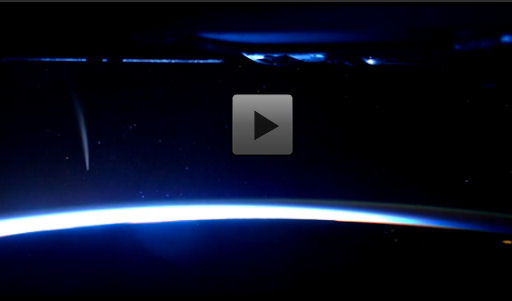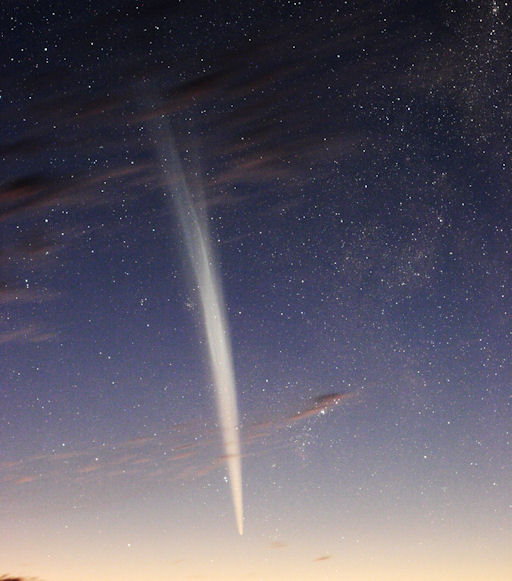Metallic photos of the sun by renowned photographer Greg Piepol bring together the best of art and science. Buy one or a whole set. They make a stellar gift. | | |
NIGHT AFTER CHRISTMAS SKY SHOW: On Dec. 26th, Venus and the crescent Moon will gather together for a beautiful night-after-Christmas sky show. Get the full story from Science@NASA.
LAST MINUTE ASTRONOMY GIFT: Running out of time? In only a few minutes, you can give the gift of Northern Lights, space station flybys, and other heavenly sights to friends and loved ones. Our unique astronomy alert services, Spaceweather Text and Spaceweather Voice, come with a handy e-Card for instant gift-giving.
COMET LOVEJOY FROM ORBIT: Veteran astronaut Dan Burbank has seen many amazing things. Once, he even flew through the aurora borealis. So when Burbank says "[Comet Lovejoy] is the most amazing thing I have ever seen in space," it really means something. Currently serving onboard the International Space Station, Burbank photographed the sungrazing comet on Dec. 21st, an experience he describes in this NASA video:

Burbank describes the tail of Comet Lovejoy as a "green glowing arc at least 10 degrees long." He saw it just before orbital sunrise emerging from Earth's limb, which was "lit up as a bright sliver of blue and purple."
After plunging through the sun's atmosphere only 120,000 km above the stellar surface on Dec. 16th, and improbably surviving, Comet Lovejoy has become the finest comet since Comet McNaught in 2007. Its orbit is carrying it through the skies of the southern hemisphere where sunrise sky watchers are seeing the comet almost as clearly as Burbank did. Amateur astronomer Lester Barnes sends this Dec. 23rd picture from Port Lincoln, South Australia:

"Fantastic view--one to remember," says Barnes. "The comet was bright; this is 1 minute exposure I took using my Canon 20Da digital camera."
The visibility of Comet Lovejoy should continue to improve in the days ahead as the comet moves farther away from the sun. Early-rising sky watchers in the southern hemisphere should remain alert for this amazing apparition. [finder chart]
more images: from Yuri Beletsky of Santiago, Chile; from Shane Ocean of Whitsundays, Australia; from Hernán Stockebrand of Vicuña, Chile; from Giovanni of Paysandù Uruguay; from Andy Dodson of Huirangi, New Zealand; from Rodolfo Chiaramonte of Vera Cruz, São Paulo, Brazil; from James Tse of Christchurch, New Zealand; from Emilio Lepeley of Vicuna, Chile; from Rogerio Marcon of Campinas SP Brasil; from Stephen Chadwick of Himatangi Beach, New Zealand; from Kosma Coronaios of Louis Trichardt, Limpopo Province, South Africa; from Paulo Morales Valdebenito of San Francisco de Mostazal, Chile; from Willian Souza of Sao Paulo, Brazil; from Grahame Kelaher of Perth, Western Australia; from Minoru Yoneto of Queenstown, New Zealand;
Potentially Hazardous Asteroids (
PHAs) are space rocks larger than approximately 100m that can come closer to Earth than 0.05 AU. None of the known PHAs is on a collision course with our planet, although astronomers are finding
new ones all the time.
On December 23, 2011 there were 1272 potentially hazardous asteroids.
Notes: LD means "Lunar Distance." 1 LD = 384,401 km, the distance between Earth and the Moon. 1 LD also equals 0.00256 AU. MAG is the visual magnitude of the asteroid on the date of closest approach. | | The official U.S. government space weather bureau |
| | The first place to look for information about sundogs, pillars, rainbows and related phenomena. |
| | Researchers call it a "Hubble for the sun." SDO is the most advanced solar observatory ever. |
| | 3D views of the sun from NASA's Solar and Terrestrial Relations Observatory |
| | Realtime and archival images of the Sun from SOHO. |
| | from the NOAA Space Environment Center |
| | the underlying science of space weather |

